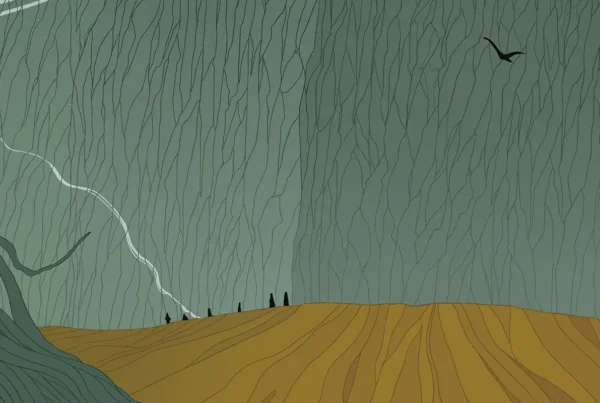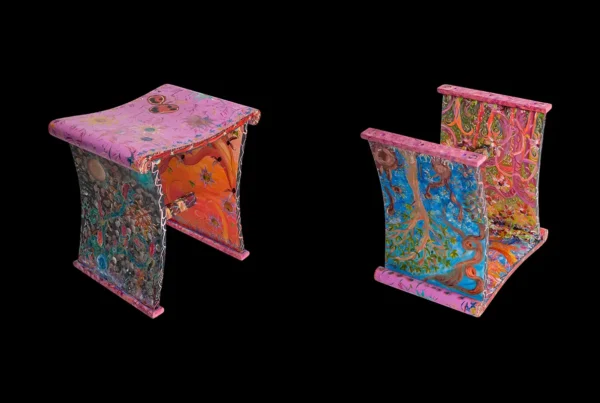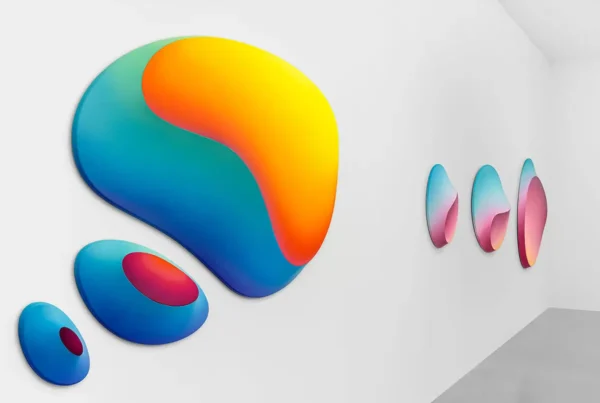The Architecture of Feeling
Katherine Duclos stands at the intersection of sensory experience, emotional insight, and structured improvisation. Born in Massachusetts in 1980, her creative evolution has been anything but linear. Although initially focused on literature—earning a summa cum laude degree in Creative Writing from Emory University in 2003—she never lost sight of visual expression. Her academic journey eventually led her to pursue an MFA in Painting and Drawing at Pratt Institute in Brooklyn, where she also obtained a K–12 Art and Design Education Certificate and was honored with the Pratt Circle Award for Outstanding Academic Achievement. Over time, her practice expanded into a rich and multi-faceted exploration of identity, space, and perception, shaped as much by her inner world as by the external one. Duclos’s work has emerged as a profound articulation of the complexities of life as a neurodivergent woman, artist, and mother, intertwining personal history with a broader aesthetic inquiry.
Central to Duclos’s creative process is her experience of neurodivergence, specifically her diagnoses of autism (including the PDA profile) and ADHD.. Rather than perceiving these conditions as limitations, she embraces them as foundational to her way of working. The physical world speaks to her differently—textures, sounds, patterns, and colors register with heightened intensity, and this heightened perception directly informs her material choices and compositional strategies. Traditional tools or step-by-step systems, like those often found in childhood building kits, may prove disorienting, yet she transforms that challenge into opportunity. For Duclos, art is not a detached activity but a daily necessity—a grounding ritual that allows her to regulate amidst unpredictability. Her studio becomes both sanctuary and testing ground, where sensory processing challenges are not obstacles but sources of insight and innovation.
This intimate connection between sensory input and artistic output is particularly visible in Duclos’s decision to work with LEGO bricks—an unconventional yet profoundly resonant material in her practice. Initially dismissive of them due to their rigidity and spatial complexity, her perception shifted when her young son, captivated by LEGO, offered her a small color pairing he thought she might like. That moment catalyzed a new trajectory. Duclos began to reimagine the bricks not as toys, but as tactile, modular color units that could be arranged, layered, and even painted to create intricate abstract works. Their dry, stackable texture suited her sensory preferences, and their inherent systemization offered a paradoxical sense of order without constraint. In this way, LEGO became more than material—it became a language through which Duclos could explore ideas of control, transition, and the poetry of color in motion.

Katherine Duclos: Compositions of Transition
Duclos’s approach to working with LEGO found renewed significance during a pivotal moment in her life—the relocation of her family after seven years in a single home. For someone whose neurodivergence is deeply affected by environmental shifts, this move was more than logistical; it was physically and emotionally destabilizing. In response, Duclos turned to her art as a stabilizing force. The modular compositions she began constructing in this period were not pre-planned; they were instead built intuitively, brick by brick, absorbing and responding to the light, colors, and emotional resonances of the space they were preparing to leave behind. These artworks, composed of individually painted bricks and altered bases, became repositories of memory. Each arrangement functioned like a visual diary entry, preserving fleeting experiences in tangible form.
Crucially, the orientation of these works is intentionally fluid. Duclos wires each piece so that it can be displayed in multiple directions, reflecting her belief in the shifting nature of memory and perception. This adaptability is not a technical afterthought but a conceptual core of the work. It acknowledges the instability of lived experience and invites the viewer to reconsider what it means to “read” a piece of art. In doing so, Duclos creates objects that are in a constant state of negotiation—between structure and spontaneity, between permanence and change. Her pieces do not dictate a single interpretation; instead, they encourage viewers to interact, question, and find their own relationships within the work’s evolving logic.
The culmination of this deeply personal exploration was presented on a larger scale in her solo exhibition at the Vancouver Art Gallery, The Light and Color We Carry. Developed during her family’s transition, the show centered on how environmental and emotional shifts manifest in visual memory. The works captured the shifting light of rooms once inhabited, the nuanced tones of familiar walls, and the subtle interplay of shadow and sun that had become part of her sensory lexicon. For Duclos, color is not merely aesthetic—it is mnemonic. Each hue in the exhibition stood as a placeholder for experience, allowing both artist and viewer to revisit and re-feel moments otherwise lost to time. Through this body of work, she revealed how deeply embedded sensory memory can be, and how art can serve as both container and catalyst for that remembrance.

Patterns Without Plans
Duclos’s methodology thrives on the balance between discipline and deviation. Every composition she creates begins with color selection—a foundational gesture that anchors the piece before any physical construction begins. From there, she builds intuitively, relying on the recursive motion of placing, adjusting, and repainting LEGO components to generate momentum. This cyclical rhythm is far from random; it mirrors the ways in which neurodivergent individuals often navigate the world—through repeated behaviors, sensory recalibration, and improvisation within limits. In her work, repetition becomes a form of meditation, and variation within that repetition becomes a space for discovery. Her practice is one of listening—both to materials and to the self—and responding with care and precision.
The importance of flexibility surfaces not only in the physical construction of her works but in their conceptual framework. Each piece resists fixedness. By designing them to be rotated and viewed from multiple orientations, Duclos emphasizes the inherent fluidity of meaning. The same configuration might evoke different emotional responses depending on how light strikes it, or how it’s positioned in space. This variability serves as a metaphor for lived experience—especially for those navigating neurodivergent realities—where no single perspective holds ultimate truth. Her work invites ambiguity and embraces multiplicity, suggesting that understanding is always partial, always evolving.
A profound example of this approach in action was her 2023 collaboration with The LEGO Group during Art Basel Miami. Commissioned to create more than 45 square feet of abstract work for their Center for Creative Flow pop-up at the W Hotel, Duclos approached the project with the same intuitive responsiveness that defines her personal studio practice. Working within a six-week window while simultaneously processing a looming move, she produced a cohesive yet exploratory series mounted on cradled wooden panels. These pieces have since been acquired by LEGO for their North American headquarters—an unexpected return to Massachusetts, the state of her birth. Accompanying this milestone was the documentary Small Tiny Starts, released on YouTube in 2024, which captures her creative process and the intimate connections between her family life, sensory experience, and evolving artistic language.

Katherine Duclos: Fluid Spaces, Shared Stories
Duclos’s relationship with her audience reflects her broader commitment to openness and inclusivity. Her work has been featured in numerous exhibitions across North America, with placements in both traditional gallery settings and innovative digital platforms. These dual modes of presentation allow her to reach a spectrum of viewers, many of whom find resonance in her themes of neurodivergence, motherhood, and sensory transformation. Through galleries such as James May and Spilt Milk, as well as local programming like the Vancouver Art Gallery Rental and Sales initiative, Duclos has cultivated a practice that is at once deeply personal and outward-facing. She frequently welcomes studio visits and invites dialogue, reflecting her belief that art should be a site of connection rather than isolation.
The accessibility of her work extends beyond physical spaces. Duclos has built a thoughtful digital presence that reflects the same principles evident in her studio: responsiveness, curiosity, and a desire for meaningful exchange. Her ability to articulate complex emotional and sensory experiences makes her work particularly impactful for those navigating similar terrains. By offering glimpses into her studio life, family interactions, and evolving projects, she demystifies the creative process and humanizes the experience of being both artist and caregiver. Her transparency fosters community, allowing others to see themselves reflected in the imperfect, beautiful mess of artistic living.
Looking forward, Duclos is preparing for a solo exhibition set to open in January of the coming year. While details remain under wraps, she shares that it will further her exploration into modularity, memory, and material responsiveness. This upcoming body of work promises to deepen the conversations she has already initiated—conversations about how we inhabit our environments, how we process change, and how creative play can become a powerful strategy for emotional survival. With an eye toward collaboration and a heart grounded in authenticity, Katherine Duclos continues to shape a practice that honors both the specific and the shared, inviting others to engage with art not as an answer, but as a companion in life’s continuous unfolding.






